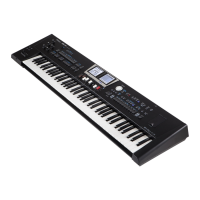Creating your own User Drum Kit
121
drum instrument name for the note key you have just pressed.
11. If you don’t need to edit some parameters that
characterize the sound of a single drum instrument,
proceed from the step 15.
Editing a Single Drum Instrument
12. Press the [QUICK MENU] button, that is ashing.
The BK-9 shows the following page:
Left Display
13. Use the dial to select the “Rhythm Tone Edit” function.
The following page is shown:
Right Display
The rst row shows the name of selected Drum instrument.
14. Press a note in the keyboard or use the dial to select the
Drum instrument to edit.
The name of the Drum instrument corresponding to the played
note is shown in the rst row.
15. Use the dial to edit the following parameters:
Parameter Value Explanation
Pitch Fine -50~0~+50
This parameter allows you to set the ne tune of the
selected Drum Instrument.
Pitch Coarse 0~127
This parameter allows you to set the coarse tune of
the selected Drum Instrument.
Chorus Send 0~127
Use this parameter to set the chorus send level of
the selected Drum Instrument.
Reverb Send 0~127
Use this parameter to set the chorus send level of
the selected Drum Instrument.
Parameter Value Explanation
TVF Type
OFF, LPF,
BPF, HPF,
PKG, LPF2,
LPF3,
Selects the type of lter. A lter modies the
brightness or thickness of the sound by cutting a
specic frequency range:
• “OFF”: No lter used
• “LPF”: Low Pass Filter. This reduces the volume
of all frequencies above the cuto frequency
(Cuto Freq) in order to round o, or un-brighten
the sound. This is the most common lter used in
synthesizers.
• “BPF”: Band Pass Filter. This leaves only the
frequencies in the region of the cuto frequency
(Cuto Freq), and cuts the rest. This can be useful
when creating distinctive sounds.
• “HPF”: High Pass Filter. This cuts the frequencies
in the region below the cuto frequency (Cuto
Freq). This is suitable for creating percussive
sounds emphasizing their higher tones.
• “PKG”: Peaking Filter. This emphasizes the
frequencies in the region of the cuto frequency
(Cuto Freq). You can use this to create wah-wah
eects by employing an LFO to change the cuto
frequency cyclically.
• “LPF2”: Low Pass Filter 2. Although frequency
components above the Cuto frequency (Cuto
Freq) are cut, the sensitivity of this lter is half
that of the LPF. This makes it a comparatively
warmer low pass lter. This lter is good for use
with simulated instrument sounds such as the
acoustic piano.
• “LPF3”: Low Pass Filter 3. Although frequency
components above the Cuto frequency (Cuto
Freq) are cut, the sensitivity of this lter changes
according to the Cuto frequency. While this
lter is also good for use with simulated acoustic
instrument sounds, the nuance it exhibits diers
from that of the LPF2, even with the same TVF
Envelope settings
TVF Cuto 0~127
Selects the point at which the lter begins to have
an eect on the waveform’s frequency components.
TVF Resonance 0~127
Emphasizes the portion of the sound in the region
of the cuto frequency, adding character to the
sound. Excessively high settings can produce
oscillation, causing the sound to distort.
TVF Env Depth -63~0~+63
Species the depth of the TVF envelope. Higher
settings will cause the TVF envelope to produce
greater change. Negative (-) settings will invert the
shape of the envelope.
TVF Env A
0~127
Specify the TVF envelope times (Time A–Time R).
Higher settings will lengthen the time until the next
cuto frequency level is reached
A D S R
L3
L1
L0
4L2L
Note off
Cutoff
Frequency
Time
Note on
TVF Env D
TVF Env S
TVF Env R
TVA Pan -63~+64 Set the pan of the tone.
TVA Level 0~127
Sets the volume of the tone. This setting is useful
primarily for adjusting the volume balance between
tones.
TVA A
0~127
Specify the TVA envelope levels (Level A–Level R).
These settings specify how the volume will change
at each point, relative to the standard volume (the
Tone Level value specied in the TVA screen).
RSDA
L3
L1
L2
Note off
Level
Time
Note on
T: Time L: Level
TVA D
TVA S
TVA R

